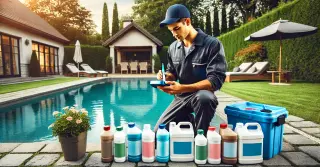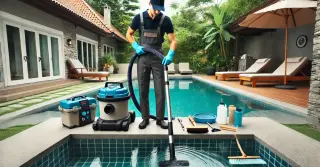Pool Chemical Balance Broadway NJ

Ensuring the right chemical balance is crucial for a safe and healthy swimming environment. Balanced chemicals inhibit algae and bacteria, maintain clear, clean water, and protect the pool's surface and equipment.
- Optimal pH Balance: Your pool's pH level is a measure of its acidity or alkalinity. Optimal pH levels range from 7.2 to 7.6. Low pH levels result in acidic water, causing skin irritation and equipment corrosion. If the pH is too high, the water becomes alkaline, leading to cloudy water and scaling on the pool surfaces. Consistently testing and adjusting pH levels is essential to maintain a comfortable and safe swimming environment.
- Monitoring Chlorine Levels: Chlorine is a key component in pool sanitation, destroying bacteria, algae, and other harmful pathogens. The ideal chlorine level should be between 1-3 ppm (parts per million). Insufficient chlorine results in unsanitary conditions, promoting bacteria and algae growth. Excessive chlorine leads to skin and eye irritation and produce a strong chlorine odor. Frequently checking and balancing chlorine levels ensures sanitation and comfort.
Optimal Alkalinity LevelsTotal alkalinity is a crucial element of pool chemistry. Alkalinity stabilizes pH levels, helping to prevent drastic changes in pH. The optimal total alkalinity range is 80-120 ppm.
- Avoiding pH Fluctuations: Proper alkalinity levels help stabilize pH levels, preventing rapid pH changes that irritate skin and damage surfaces. If alkalinity is too low, pH levels can fluctuate wildly, making balance maintenance challenging. If alkalinity is too high, it can make the water cloudy and lead to scaling. Regularly testing and adjusting alkalinity levels is essential for maintaining a stable and balanced pool.
- Calcium Hardness Control: Calcium hardness refers to the amount of dissolved calcium in the pool water. Optimal calcium hardness levels are between 200-400 ppm. Insufficient calcium causes corrosive water, damaging surfaces and equipment. Excessive calcium causes scaling and water cloudiness. Frequent calcium hardness testing and adjustments is important for protecting your pool and ensuring clear water.
Safe Handling of Pool ChemicalsHandling and storing pool chemicals properly is essential for both safety and effectiveness. Chemicals should be stored in a cool, dry place, away from direct sunlight and out of reach of children and pets. Follow the manufacturer's instructions for correct dosing and application.
- Accurate Chemical Measurement and Mixing: Precise measurement of pool chemicals is essential to maintain the proper balance. Using too much or too little can disturb chemical balance and water quality. Always use a clean, dry measuring tool and never combine chemicals directly. Mix in water as needed, following guidelines carefully.
- Awareness of Chemical Reactions: Certain chemicals can react dangerously if mixed. Never mix chlorine with acid, for example. Understanding these interactions helps prevent accidents and ensures safe handling. Keep chemicals separate and handle with caution to prevent harmful reactions.
Maintaining the proper chemical balance in your pool is essential for a safe, clean, and enjoyable swimming environment. By frequently testing and balancing pH, chlorine, alkalinity, and calcium, you can keep your pool water in optimal condition.
Proper chemical use and storage enhance the health and safety of your pool.




